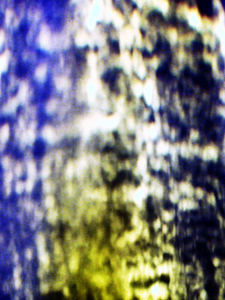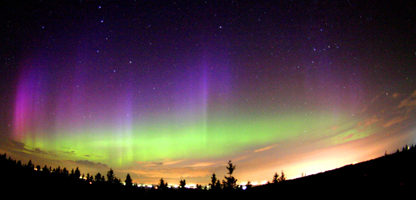What are Northern Lights?
The Northern Lights are beautiful, natural displays of dancing lights that can be seen all over the world near places like Alaska and Canada, to name a few. These lights are actually electrically charged particles that come from the sun, and then enter the Earth's atmosphere, causing the lights to be visible by the human eye. Another name for the Northern Lights is the "Aurora Borealis" in the northern hemisphere, and beautiful colors of green, blue, and even violet can be seen high in the sky. The Northern Lights often take on many forms, and sweep across the sky with shapes such as streamers, rays of light, and sweeping curtain-like shades of color.
- Everyday Mysteries - Find out what the Northern Lights really are.
- Aurora Borealis Facts - Discover facts and interesting information about the Aurora Borealis.
- The Northern Lights of Alaska - Learn about the beautiful Northern Lights over the state of Alaska.
|
What causes the Northern Lights? The Northern Lights are caused by gas-like particles within the Earth's atmosphere colliding with the charged particles coming from the atmosphere of the sun. The different colors are caused by the colliding particles, and each particle has its own properties, giving them a bright glow. The most typical color is a greenish yellow hue, and this is caused by oxygen molecules that can be found around 60 miles up above the earth. The red colors of the Northern Lights are rarer, but these can be seen as well and are caused by higher altitude oxygen particles that can be found up to 200 miles above. The bluish and purple colored aurora is the results of nitrogen particles. |

|
Since around 1880, scientists have linked the Northern Lights with sunspot activity. These mysterious glowing lights have long been a source of wonder for those who have been lucky enough to see them. Around the 1950s, new research began to indicate that both electrons and protons coming from the sun are sent towards the earth via a "solar wind". Today, research about the Northern Lights is still being conduction at a facility in Fairbanks, Alaska known as Poker Flats.
Above the sun's surface, the temperature is approximately several million degrees Celsius. Because of such a high temperature, the gas molecules collide and create an explosive effect. As a result of these explosions, electrons and protons are dispersed from the sun's atmosphere after it rotates, and then escape from holes in the magnetic field. The solar wind then blows the particles around, and the light is deflected. Since the earth's magnetic field is less strong at both the north and south poles, these particles tend to enter the atmosphere and collide with gas particles. The light results from these particle collisions, and creates the dancing, wondrous effect known as the Northern Lights. These light effects cannot be seen from indoors if you have track lighting fixtures installed. The light emitted from track lighting fixtures will make it difficult to view the explosive lighting display of the Northern Lights.
- What Makes the Lights Shine? - Find out what creates the beautiful colors and glow of the Northern Lights.
- Causes - A brief overview about what causes the Northern Lights.
- What Causes the Aurora? - Information on what happens to create the aurora is available here.
Where is the best place to watch the Northern Lights?
Alaska and Canada are both very popular places that tourists enjoy looking for these natural marvels. The territories of the Yukon, Nunavut, and Northwest Territories of Canada, along with Fairbanks, Alaska, are popular spots to try to behold these wonders. Some scientists claim that these lights can happen at the same time on both the north and south poles, with very similar shapes and colors occurring simultaneously. These lights have actually been seen as far south as New Orleans, Louisiana on very rare occasions. Still, the best place to find the Northern Lights is far away from big cities and closer to remote locations like the southern tip of Greenland or Iceland, and the coasts of Norway or Siberia. The southern auroras can be seen near Antarctica and the southern part of the Indian Ocean.
- In Alaska - Find out the best times and places in Alaska to view the lights.
- Paintings in the Sky - Where can you see both the Aurora Borealis and the Aurora Australis?
- Can you see aurora where you live? - Find out where the best locations to view the northern lights are?
When is the best time to watch for auroral displays?
While it's tough to pinpoint the exact best time to catch the beautiful auroral displays, scientists have determined that these lights tend to run on cycles that peak every eleven years or so. The next “peak” time is slated for the year 2013. Another great time to view the Northern Lights is during the winter, since there are long periods of dark skies. Clear nights around midnight is an excellent time to take a look up at the sky and look for these colorful displays of lights.
- Viewing Tips - Some helpful tips on viewing the aurora from NOAA.
- Viewing Times in Ontario - An article explaining good viewing times in Ontario, Canada.
- Aurora Forecast - The Aurora Forecast tells you the best times to view Auroral activity on a given day.
Legends of the Lights
The nickname Aurora borealis translates into "dawn of the north." For the southern hemisphere, the lights are known as Aurora australis. The goddess Aurora was a Roman goddess of the dawn, and has sparked many legends about the famous lights. During medieval times, people viewed the lights as a bad sign of potential war or famine that was to come. In New Zealand, the Maori tribes believed that the Northern Lights were actually reflections from others' campfires or hand held torches. In America many people with contemporary ceiling fans refer to the lights as "light fans north". Most of the contemporary ceiling fans affect the decisions of these people because they live in modern homes. In the state of Wisconsin, the Indian tribe known as the Menominee actually believed the lights were the spirit of giant hunters or fishermen. In Alaska, Inuit tribes thought the lights were the spirits of the animals they hunted such as salmon, deer, seals, or beluga whales. Other tribes thought the colorful lights represented the spirits of people who had passed.
- Legends and Folklore - This page contains some legends and stories about the Northern Lights.
- Folklore of the Aurora - Some interesting folklore that has surrounded the Aurora over the centuries.
- Aurora Mystery - The history of the Aurora borealis is full of interesting facts and legends. Find out about them here.
More Information on the Northern Lights

- Checking out the Northern Lights
- Images Database
- FAQs: Lights in the Yukon
- Alaska's Northern Lights
- Aurora Watch UK
- The Aurora Page
- What is the Aurora Borealis?
- Capturing it on Film
- The Lights in Finland
- Gaze at the Aurora Borealis
- Aurora Borealis Predictions
- Aurora Polaris
- Questions Answered
- Traveler's Guide to the Aurora Borealis
Article Written by +Colby Harris
| Fans & Air Quality | Interior & Exterior Lighting | Best Sellers |
|---|---|---|


